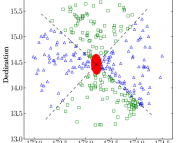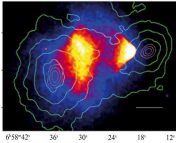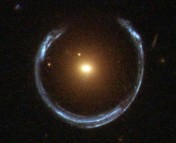Title: Detection of an unidentified emission line in the stacked X-ray spectrum of galaxy clusters
Authors: Esra Bulbul, Maxim Markevitch, Adam Foster, Randall K. Smith, Michael Loewenstein, Scott W. Randall
First author’s institution: Harvard-Smithsonian Centre for Astrophysics
Status: Published in The Astrophysical Journal, available on arXiv
Dark matter is frustratingly elusive. Despite the wealth of indirect astronomical evidence for its existence, dark matter has continued to escape direct detection. To date, teams of particle physicists have not yet been able to trap a dark matter particle in laboratory experiments based on the properties predicted from leading theories.
Indirect searches for dark matter rely on finding “signatures” that inform us as to its existence. These searches look for visible products of dark matter interactions, based on the vast amount we know to be present all around us in the cosmos.
Particle dark matter can leave high energy imprints such as gamma-ray photons or energetic charged particles, known as cosmic rays. Gamma-ray excesses due to dark matter are being investigated by the Fermi Gamma Ray Space Telescope, while cosmic rays are being probed with the Dark Matter Particle Explorer (DAMPE) satellite.
One exciting example of an indirect dark matter search has come from searching the sky in the X-ray part of the spectrum. Specifically, the authors present a discovery of an unidentified emission line in the X-ray spectra of multiple galaxy clusters. This line is present at the same energy in each individual spectrum, at approximately 3.5 kiloelectronvolts (keV).
Galaxy clusters contain hundreds of galaxies, trillions of stars, and an energetic plasma between galaxies, which shines in X-rays. When we look at the composition of this X-ray gas using spectroscopy, we can observe emission lines that tell us about metals and charged particle interactions within the cluster. The authors claim that the 3.5 keV emission line is not the result of any known charged particle transitioning between energy states and therefore has an unidentified origin. They go on to suggest this line could be a signal from a dark matter candidate known as the sterile neutrino.
A sterile neutrino decay should produce photons of an energy that is exactly half of the sterile neutrino mass. The sterile neutrino mass is predicted to be in the keV range, therefore, the resulting energy from a decay should be visible in X-ray observations. Since 90% of a galaxy cluster’s mass is locked up in dark matter, the number of predicted decay events (about 1070 interactions per second) from sterile neutrinos should produce a signal detectable by X-ray telescopes.
The authors searched for the signal by first taking observations of 73 galaxy clusters from the ESA X-ray telescope, XMM-Newton. Because the detection of a dark matter signal would be very weak in each individual cluster, the 73 spectra are stacked on top of each other in order to boost the strength of the signal, whilst removing systematic effects known as “noise.”
However, each of the clusters is at a different distance from us. As a result, the emission features in each spectrum are redshifted according to the distance to the cluster. To counter this, each cluster spectrum must be blueshifted back into the rest-frame (i.e. z = 0) to ensure all emission lines (including one possibly from dark matter) line up. Then the clusters spectra can be stacked. Finally, a model is fit to the cluster spectrum. Where there is an excess of photons relative to the model, it is possible to infer the presence of a new, unidentified emission line. This is what the authors found:

Figure 1. A stacked spectrum of 73 galaxy clusters in the 3-4 keV energy range. The cluster model is in red, and data-points in black. The discrepancy between model and data at ~3.5 keV is highlighted with the arrow. Figure 6 in the paper.
The excess of photons relative to the model here has a statistical significance of at least 3-sigma. This means that the probability that this is a genuine detection, rather than a statistical fluctuation, is greater than 99.7%.
Although this is an exciting result, it’s not the complete picture. To verify that the stacked sample of clusters hasn’t simply been contaminated by an anomalous emission line from one nearby, bright cluster, they repeat the analysis on subsamples of bright clusters alone.
Focusing only on the nearby Perseus cluster, the authors find the presence of a line at the same energy – 3.57 keV – but much brighter than expected. In other words, the line is too prominent for the amount of dark matter mass in Perseus. The authors suggest that the dark matter signal in Perseus could in fact be simply the detection of an argon atomic line that has a similar energy.
The authors then examined a stacked sample of three nearby bright clusters: Centaurus, Ophiuchus and Coma. In this subsample, an unidentified signal was not reported to any statistical significance in one of XMM’s detectors, but showed consistent results with the overall sample in another detector.
Although it seems nearby clusters have some differing results as to the origin and significance of this intriguing emission line, the overall cluster sample still finds strong evidence for one in an energy range consistent with sterile neutrino models.
This tantalising result has since inspired a flurry of follow-up papers. “Local” searches in the Milky Way halo and nearby dwarf galaxies have struggled to detect a significant signal, while Hitomi’s detailed spectroscopy of the Perseus cluster similarly found no evidence of a 3.5 keV line. This makes the original detection all the more curious, and in need of follow-up from the next generation of X-ray calorimeters (XRISM) and X-ray telescopes (eROSITA). Then we can perhaps confirm whether the elusive dark matter needle was inside an X-ray stack after all.
Featured image credit: X-ray: NASA/CXO/Oxford University/J. Conlon et al.; Radio: NRAO/AUI/NSF/Univ. of Montreal/Gendron-Marsolais et al.; Optical: NASA/ESA/IoA/A. Fabian et al.; DSS




